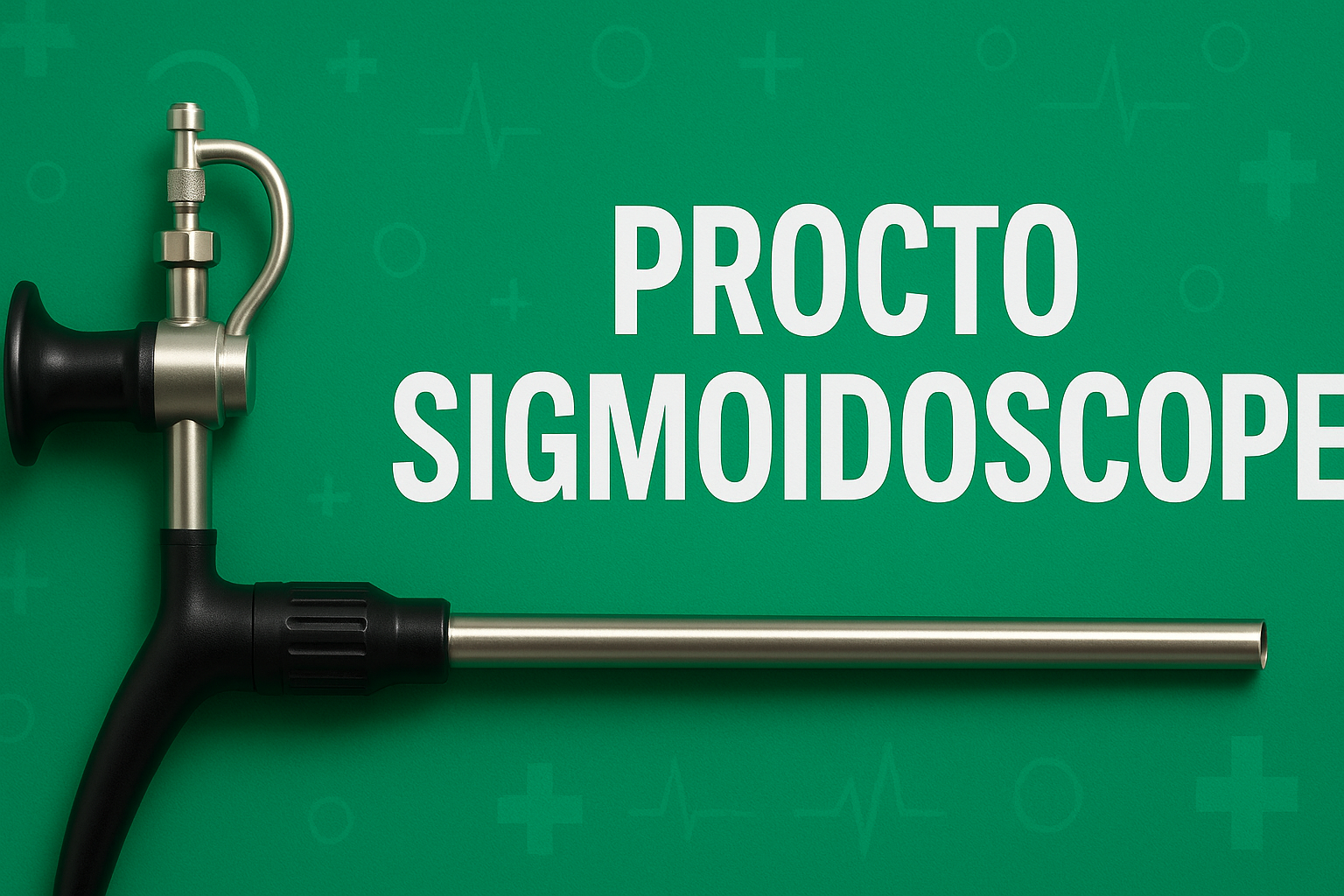Understanding the Procto Sigmoidoscope: A Key Tool in Colorectal Diagnosis
When it comes to diagnosing lower gastrointestinal (GI) disorders, medical professionals rely on a range of specialized tools. One such device is the Procto Sigmoidoscope a critical instrument used in examining the rectum and sigmoid colon. This tool allows doctors to visualize the inner lining of the lower part of the colon and is especially helpful in detecting conditions like colorectal cancer, polyps, inflammation, and other abnormalities. In recent years, the evolution of technology has enhanced the traditional Procto Sigmoidoscope into more advanced and efficient diagnostic equipment.
What Is a Procto Sigmoidoscope?
A Procto Sigmoidoscope is a rigid or flexible tubular instrument fitted with a light source and a camera or viewing lens. It is inserted into the rectum and advanced through the sigmoid colon. The rigid version is usually employed for shorter examinations, while flexible sigmoidoscopes are used for more extensive visualization. It enables healthcare providers to directly observe the mucosa of the rectum and lower colon, obtain tissue samples (biopsies), and even remove small polyps.
Unlike a full colonoscopy, which examines the entire colon, sigmoidoscopy focuses only on the lower portion. This makes the procedure quicker and, in many cases, more comfortable for patients, particularly when anesthesia is not required.
Importance in Medical Diagnosis
The Procto Sigmoidoscope plays a pivotal role in the early detection and management of several colorectal conditions. Since symptoms like rectal bleeding, chronic diarrhea, constipation, and unexplained abdominal pain can be linked to serious underlying problems, this procedure becomes a valuable diagnostic step.
One of the most critical applications is in colorectal cancer screening. Early detection through sigmoidoscopy significantly improves treatment outcomes. Physicians can detect small growths or precancerous lesions and remove or biopsy them before they turn malignant.
Additionally, this procedure is used to monitor chronic conditions like ulcerative colitis and Crohn’s disease. It helps in assessing the extent of inflammation, guiding treatment decisions, and evaluating the response to medication.
How the Procedure Works
Before undergoing a sigmoidoscopy, patients are generally required to empty their bowels using enemas or a prescribed laxative. No full colon cleanse is necessary, unlike a colonoscopy.
The patient lies on their side, and the doctor gently inserts the lubricated Procto Sigmoidoscope into the rectum. Air may be introduced into the colon to inflate it slightly, allowing for a clearer view. Patients may feel a mild cramping or pressure during the procedure, but it is usually tolerable and brief.
The video version of the instrument allows for real-time observation and recording, improving the accuracy of diagnosis. If abnormalities are observed, biopsies can be taken immediately using specialized tools passed through the scope.
Advantages of Using a Procto Sigmoidoscope
The advantages of this instrument are numerous, especially with technological advancements that have improved both patient comfort and diagnostic capabilities:
-
Minimally Invasive: The procedure does not require surgery, making it safer and easier to perform in outpatient settings.
-
Quick Recovery: Most patients can return to normal activities the same day without any lasting discomfort.
-
Cost-Effective: It is generally less expensive than a full colonoscopy, making it a more accessible option for routine screening.
-
Early Detection: It can catch abnormalities at a stage when they are most treatable.
-
Real-Time Visualization: Modern versions include HD video capabilities, enabling clear, precise imaging for better diagnostic accuracy.
Limitations of the Procedure
While the Procto Sigmoidoscope is a valuable diagnostic tool, it does have limitations. Since it only examines the lower part of the colon, it may miss abnormalities in the upper colon or cecum. For comprehensive analysis, a full colonoscopy might still be required.
Another limitation is patient discomfort. Although less invasive than some procedures, it may still cause anxiety or embarrassment for some individuals. However, proper patient education and reassurance can minimize these concerns.
Additionally, not all lesions or abnormalities can be treated during a sigmoidoscopy. In some cases, further procedures are necessary to fully remove or assess findings.
Technological Advancements in Procto Sigmoidoscopes
The traditional models have seen significant enhancements with the introduction of rigid video Procto Sigmoidoscopes, which combine fiber-optic technology with high-definition video imaging. These devices provide clearer images, better illumination, and more precise control for physicians.
The integration of video recording is particularly useful for documenting findings, teaching medical students, and reviewing complex cases. Some models also come with attachments for insufflation, irrigation, or biopsy, making the procedure more efficient.
These innovations have increased the popularity of sigmoidoscopy as a first-line diagnostic test, especially in facilities with limited resources where full colonoscopy might not be readily available.
Clinical Applications Beyond Screening
Apart from cancer screening and inflammation assessment, Procto Sigmoidoscopy has several other clinical applications:
-
Rectal bleeding evaluation: Identifying hemorrhoids, fissures, or tumors.
-
Foreign body retrieval: Useful in removing small objects lodged in the rectum.
-
Surveillance: Post-polypectomy follow-up or checking recurrence of previously treated conditions.
-
Infectious disease detection: Diagnosing rectal infections, especially in immunocompromised patients.
Preparing Patients for Sigmoidoscopy
Proper preparation is key to a successful procedure. Patients should be informed about the purpose, process, and potential discomforts involved. Clear instructions regarding dietary restrictions and bowel preparation should be provided in advance.
Patients should also disclose any medications, especially blood thinners, which might need to be paused. Ensuring that patients are mentally and physically prepared helps improve cooperation and reduces the risk of complications.
The Future of Procto Sigmoidoscopy
With increasing emphasis on preventive healthcare and early detection, the role of sigmoidoscopy is likely to expand further. Continued advancements in imaging, miniaturization, and patient-friendly designs are making the Procto Sigmoidoscope more effective and less intimidating.
In developing countries and remote areas, portable versions of the device can be instrumental in extending screening services to underserved populations. Telemedicine integration might also enable remote guidance during procedures, allowing specialists to assist local practitioners.
Conclusion
The Procto Sigmoidoscope is an indispensable tool in the realm of gastrointestinal diagnostics. It bridges the gap between patient symptoms and accurate diagnosis, offering a safe, efficient, and cost-effective solution for examining the rectum and sigmoid colon. With continuous innovation and increased awareness about colorectal health, this procedure is set to play an even greater role in modern medicine.
By enabling early detection and management of potentially life-threatening conditions, sigmoidoscopy not only saves lives but also contributes significantly to reducing the healthcare burden associated with advanced gastrointestinal diseases. Its value in medical practice remains as relevant today as ever—and only continues to grow.







